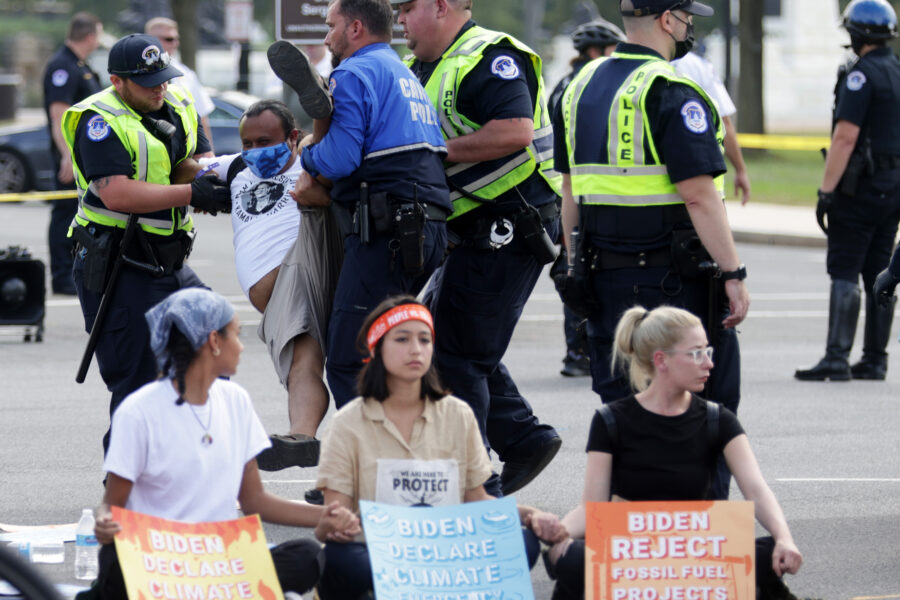New York Activists Descend on the Hamptons to Protest the Super Rich Fueling the Climate Crisis
Sophie Shepherd has always described herself as a “rule follower,” but days before her 22nd birthday, she chose to face arrest in the middle of a Long Island driveway. Under a blazing hot July sun, two police officers sawed through the PVC pipes that connected her arms to the 13 other protesters blocking the entrance to a private airport.
“What I love about direct action is you’re actually getting in people’s faces and disrupting their way of life,” Shepherd said. “That push is what’s necessary to change the temperature in the room.”
Last month, Shepherd and around forty other climate activists from New York City and Long Island descended on the East Hampton Town Airport to heat up the conversation on how the super rich drive global warming.
As police separated and arrested the demonstrators blocking the driveway, other activists in the group surrounded them carrying plastic pitchforks and posters that read “tax the rich.” Their bright red t-shirts read, “billionaires, what are you saving up for, hell?” above a graphic of cash burning. A five-year-old holding a pitchfork and a homemade poster started a chant: “stop private jets, stop funding oil!” Behind them, in the distance, sat a few rows of private planes and helicopters.
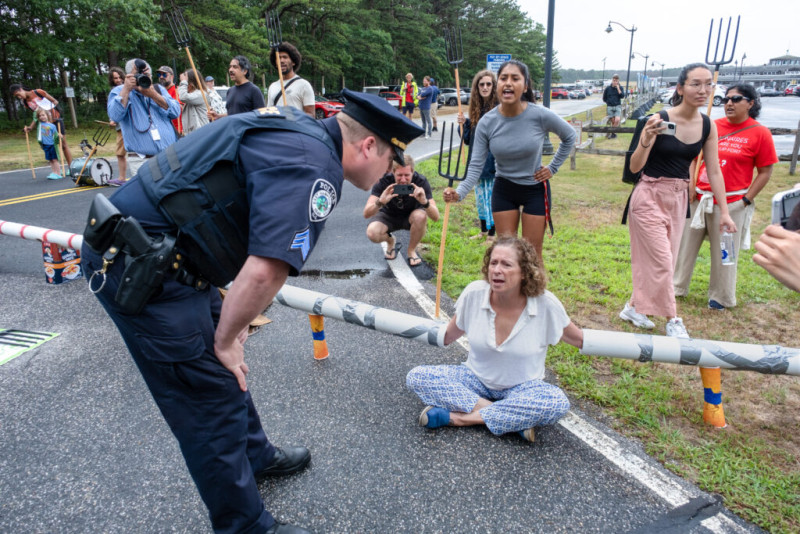

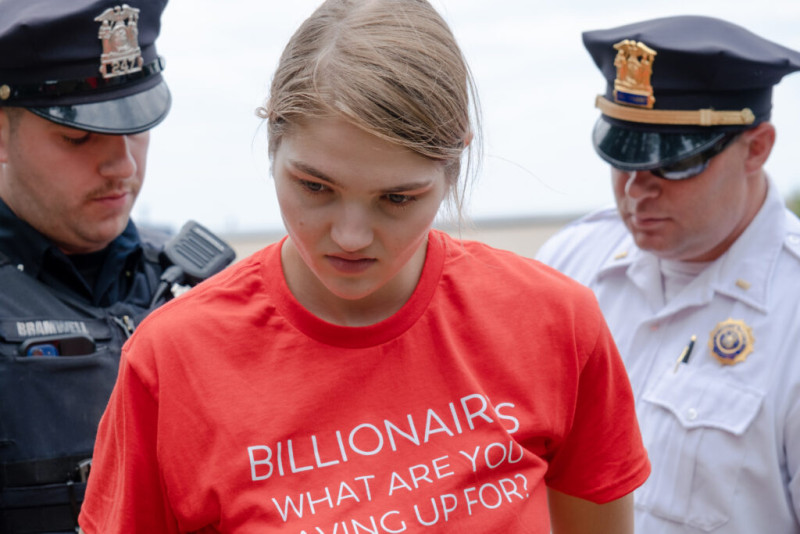
The airport blockade was only the first of eight actions that weekend organized by New York Communities for Change (NYCC), Planet over Profit and Sunrise Movement NYC. In addition to shutting down the airport—for which Shepherd and 13 other protesters were arrested—the activists marched for a wealth tax with leaders from the Shinnecock Indigenous nation, crashed an exclusive golf course, stormed a museum gala, demonstrated outside the private homes of a Citibank chairman and a private equity billionaire and stirred up climate conversations at two high-end restaurants.
The racially and socioeconomically diverse coalition of activists sought to draw attention to the disproportionate role the ultra-wealthy play in filling the atmosphere with greenhouse gasses, advocate for a wealth tax to fund climate justice initiatives and pressure top fossil fuel beneficiaries to stop funding climate-warming activities. During their weekend together, the activists also grappled with what it takes to win lasting change in a stubborn world.
‘The Most Rational Choice’
Alice Hu felt for a moment that she was outside of her body as she watched the action at the airport.
Holy shit, she thought. This is our lives?
Hu, senior climate campaigner for NYCC, a New York City organization focused on base-building, direct action and legislative advocacy, had been planning for this action for over a month.
Lifting up a red-and-white megaphone, she addressed the crowd.

“We are here because the grotesquely wealthy’s reckless consumption is costing us the future,” she yelled, prompting cheers and cries of “tax the rich!” from the crowd. “We are here because some of the same people who recklessly fly private jets all over the world are the same people whose fossil fuel investments…[are] actively destroying our planet and our future.”
Shutting down the Hamptons airport was meant to be a disruption to the status quo, a minor inconvenience for people who can afford to fly on private jets, which can be up to 14 times more polluting per passenger than commercial jets.
“It may seem like a radical choice for folks to be putting their bodies on the line today,” Hu said. “But if I can make one thing clear, it’s that this is the most rational choice.”
Her head was still full of logistical details—ensuring the safety and comfort of the protesters, speaking with the press, dealing with the public and monitoring the police with a particularly watchful eye for crackdowns on civil disobedience that have grown more severe in recent months. But she also felt excited by the boldness of her team’s action and the shared energy it had created. Later, while waiting for protesters to get out of jail, she described it as “collective effervescence,” like the feeling of being in the crowd at the end of an epic sports game.
Wealth and the Climate Crisis
Globally, those who have contributed least to the climate crisis are facing its most dire impacts—heat waves, flooding, drought and crop failures—and the world’s poorest economies often depend on the industries most vulnerable to global warming. Meanwhile, the world’s wealthiest populations are emitting climate-warming gasses at unprecedented rates, while largely able to shield themselves and their riches from the consequences of their lifestyle.
From 1990 to 2015, the richest 1 percent globally contributed two times more emissions than the half of the world’s population with the least wealth. According to World Inequality Lab data from this year, the top 10 percent of the world’s emitters are responsible—through consumption and private investments—for half of global greenhouse gas emissions. The top 1 percent have contributed more to emissions growth in recent decades than the half of the world’s population with the lowest emissions.
Each of the world’s richest billionaires are responsible for an estimated average of 3 million tonnes of carbon dioxide emissions a year, more than one million times the average for an individual in the bottom 90 percent of emitters, according to a 2022 report from global anti-poverty organization Oxfam.
“It’s a shame to know that these are the people who don’t want nothing to happen in terms of climate [action],” said Leroy Johnson, longtime organizer and vice-chair of the NYCC board, while gesturing to a Hamptons bay full of private boats. “They want more money, they’d rather people die than do the right thing.”
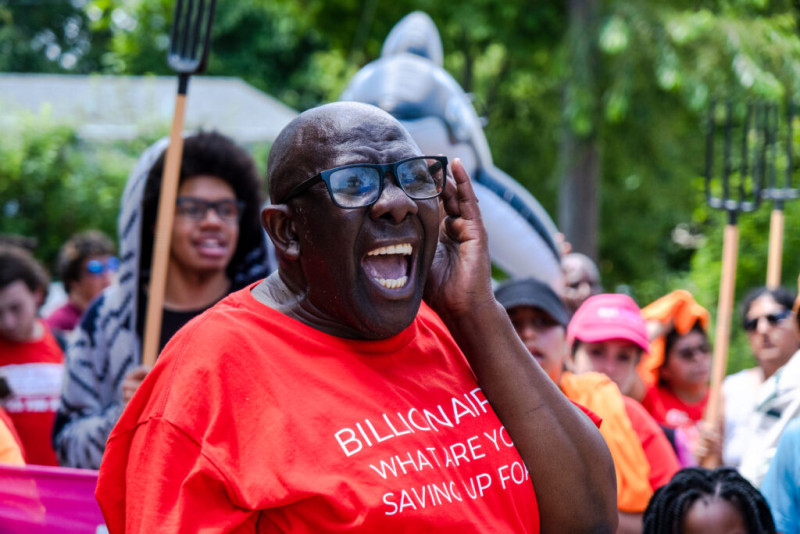
The Hamptons placed second in a recent ranking of the world’s top seasonal hotspots for multi-millionaires: the area has 25 year-round residents with investable assets of $100 million or more, and hosts more than 700 during the peak summer season.
This year’s Hamptons’ actions were a continuation of an NYCC tradition that began in 2020, when some NYCC members—mostly low-income Black and brown New Yorkers—were unable to buy groceries or pay rent during the pandemic, and saw the city’s wealthiest inhabitants flee to their second and third homes in places like the Hamptons. They organized a car caravan and brought more than 200 protesters to the Hamptons to draw attention to the wealth disparity.
Alicé Nascimento, NYCC’s campaigns director, said the Hamptons made this divide particularly clear.
“It’s this very dystopian, weird place,” she said. “It’s a kind of version of what exists everywhere else, [but] magnified.”
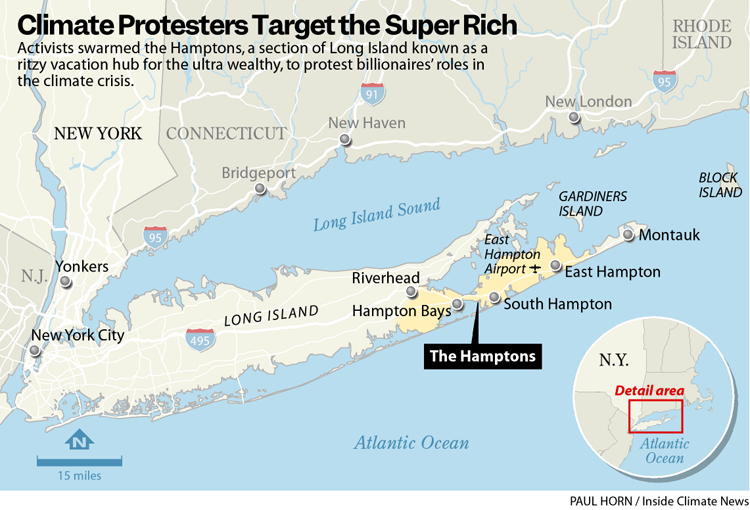
For NYCC member Rachel Rivera, 44, the connection between the climate crisis and wealth is personal. Rivera joined NYCC in 2012 after losing her home in the Bedford-Stuyvesant neighborhood of Brooklyn to Hurricane Sandy. She remembers waking up in the middle of the night to flooding and running through her home to wake up her five children, carrying out the youngest from her bed just before the ceiling caved in as they ran to find safety.
Rivera and her children stayed in evacuation shelters—gymnasiums full of displaced families—until the city shuttled them to a hotel in Midtown Manhattan, where she was questioned by the city because she didn’t have a kitchen to cook for her family.
“I didn’t choose to become homeless,” she said. “I was displaced.”
Rivera, who now lives in the Brownsville neighborhood of Brooklyn, started working with NYCC to help others in situations similar to her own and is now a leader with the organization, helping to organize and execute actions and campaigns throughout the city, and pushing for legislation including limitations on gas usage and the city’s groundbreaking 2019 building emissions reduction law.
Rivera now has six kids, ranging in age from 9 to 27, and says her activism is for them.
Grass Roots Meet Manicured Lawns
NYCC operates a network of neighborhood-based chapters and asks members—some struggling to pay their regular bills—for dues of $10 a month. In addition to getting NYCC members invested in the organization’s activities and success, Nascimento said this funding model ensures that the members are in charge: they’re paying NYCC staff’s salaries.
“We work for them,” she said. “We are nothing without them.”
But NYCC organizer Darinel Velasquez says it makes him uncomfortable to ask for dues from people who are already struggling financially.
“That’s been a huge difficulty for me, is asking for poor people to help contribute financially,” Velasquez said. “I don’t wanna be like, ‘I’m gonna help you, but before I help you, you gotta pay up.’”
Rivera, who’s been an NYCC member for over ten years, said she doesn’t find the dues to be a financial burden and pays them because she believes the work is important.
In recent years, NYCC has helped New Yorkers secure pandemic tenant relief and affordable housing in addition to its work helping to pass critical climate laws in New York City, including controls on building emissions and gas usage. The organization currently has about 20,000 members.
NYCC is fighting against the narrative that low-income people of color don’t care about climate change, Nascimento said. By connecting the climate crisis with issues like green, affordable housing, jobs and health, they are focusing on aspects of global warming that are most relevant to working class New Yorkers’ daily lives. NYCC’s model builds lasting people power by investing in long-term relationships with members, like Rivera and Johnson, who will sustain their energy and investment in organizing for decades.
“I’m 44 years old with six kids, and I’m still out here,” Rivera said. “[If] you wanna see a better future, get off your ass and start moving.”
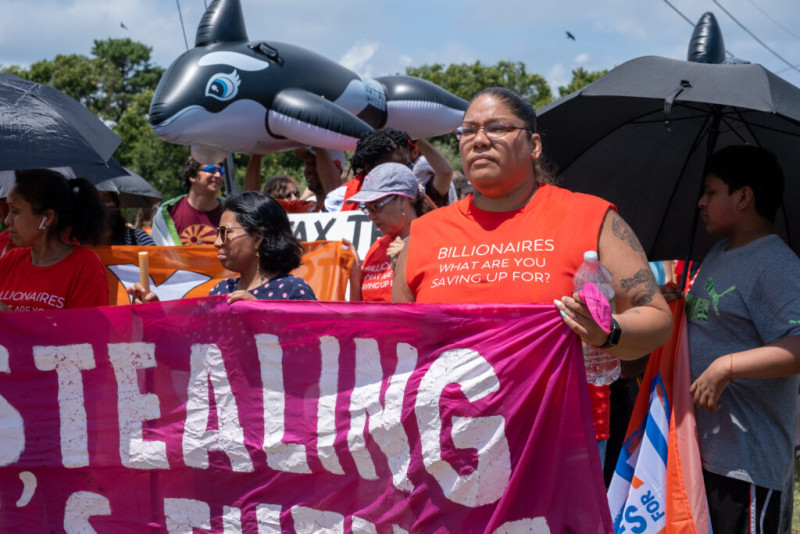
The lakeside rental house the activists stayed at looked like a typical Hamptons vacation house: white walls and furniture with a large wooden arrow bearing the word “beach” sitting on the mantle. But this weekend, a climate clock in one corner was ticking with a countdown: 6 years, 6 days left to limit global warming to 1.5 degrees Celsius. A guitar plastered with stickers like “Unfuck the world,” was often leaning against a couch. Some activists commuted in from the city for specific actions, while others stayed as long as five days in the rental house, cooking communal meals and setting up air mattresses and sleeping bags on the floor.
One night, huddled into a corner of the living room next to two activists playing a game of chess, 20-year-old Martin Gioannetti grilled Hu and Nascimento about theories of organizing and how they found energy to keep going.
Changing public consensus is a commitment to a long game, Nascimento said.
“I am so at peace with the fact that I’m going to die fighting,” she said.
For Hu, being part of the movement feels almost mandatory.
“I don’t really feel like I have a choice,” she said. “You have to believe you can do something, that’s the job of an organizer.”
At some point, four activists clad in orca costumes sauntered in and the room turned into a dance party, singing along to Miley Cyrus’ “Party in the U.S.A.,”doing the “Cha-Cha Slide,” and taking turns in the orca suits.
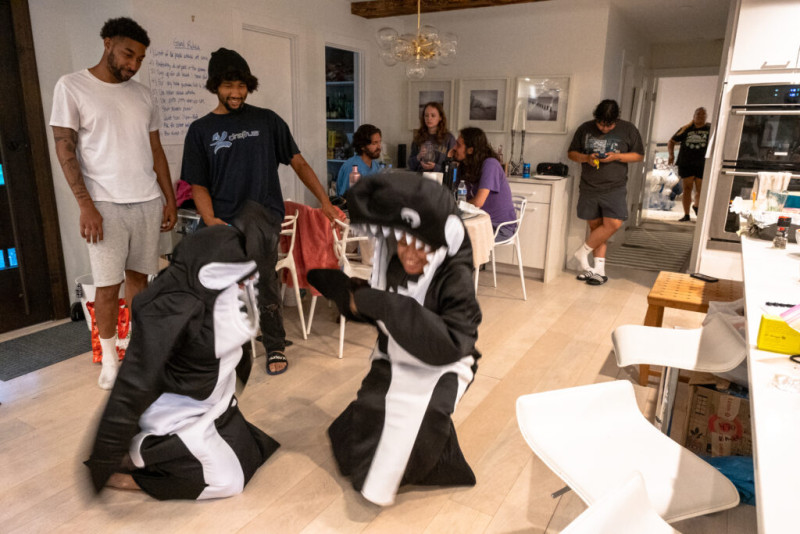
“You have to find joy in the movement,” Nascimento said. “Action is the antidote to despair.”
The 14 protesters arrested at the Friday airport action spent from four to nine hours in the East Hampton Jail, playing games and making paper airplanes to pass the time. Most of them were from Planet Over Profit or Sunrise Movement NYC, and were in their late teens or twenties, with the exception of Abigail Disney, the 63-year-old great-niece of Walt Disney.
“It feels good to be out,” Disney said, smiling as she met the other activists outside the jail.
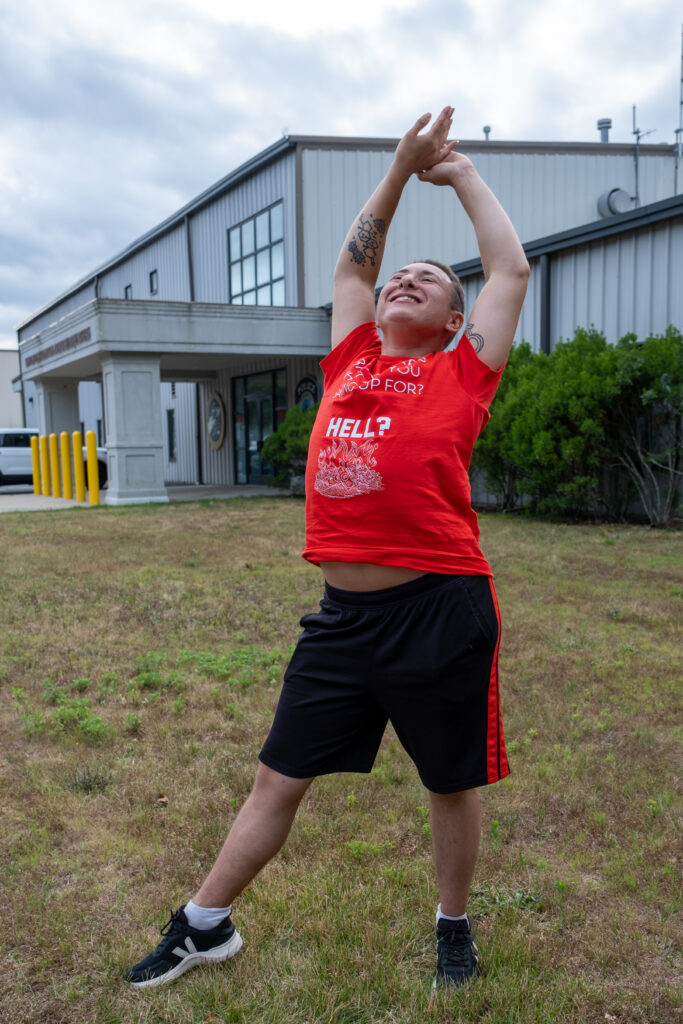
Disney used to fly on her father’s jet, until she realized its climate implications and the hypocrisy of talking about environmentalism while traveling with such a huge carbon footprint, she said.
“Have a look at what you’re creating in the world and take responsibility for it,” she said. “I don’t care how rich you are, you’re just a person…it doesn’t give you license to destroy the planet for everyone else.”
The next day, the activists held their biggest action of the weekend, a march with leaders from the Shinnecock Nation behind a bright pink banner that read, “The 1% is stealing everyone’s future.” As the marchers passed a bay full of private boats and residential roads with bright, white mansions and manicured lawns, bystanders stopped to watch, some pulling out their phones to film. A few residents made derisive comments to the protesters, while other passersby in cars honked and cheered their approval.
The activists’ grass-roots efforts highlighted the insulation that wealth provides in the Hamptons.
That night, about 16 of them attempted to crash a benefit at the Parrish Art Museum to call out one of the events’ sponsors, Bank of America, for funding fossil fuel projects, but security intercepted them and forced them off the premises.

On Sunday, torrential rain and flood warnings put all the actions on pause. All day, Rivera was thinking about her daughter, whose post-traumatic stress from Sandy is triggered by heavy rain.
The following day, the activists visited the homes of John C. Dugan, chair of Citigroup Inc., and Henry Kravis, co-founder of the private equity firm KKR, calling out both men and their companies for massive investments in fossil fuels. They also called for a wealth tax, a model that would tax the ultra wealthy to fund equitable climate change adaptation and mitigation efforts in poorer countries and communities. Outside the homes, police officers warned them that demonstrating near residential addresses was a violation of village ordinances.
Ashley Bedoya, a 22-year-old who grew up in Southampton and stopped by the action at Kravis’ house, said the disparities between the Hamptons’ ultra-wealthy and working class populations are growing. Many of the friends she grew up with have moved away due to the area’s increasing unaffordability.
“To grow up around the billionaires, [while] barely being able to afford my family home to this day, it’s obviously very frustrating,” she said.
The activists also protested at the Sebonack Golf Club until they were chased off the course by police.
“It feels like there’s something in the air here,” Nascimento said of the starkness of the wealth divide in the Hamptons. “Increasingly, people are seeing that this is not normal, it’s not okay.”
Disclaimer: The copyright of this article belongs to the original author. Reposting this article is solely for the purpose of information dissemination and does not constitute any investment advice. If there is any infringement, please contact us immediately. We will make corrections or deletions as necessary. Thank you.
